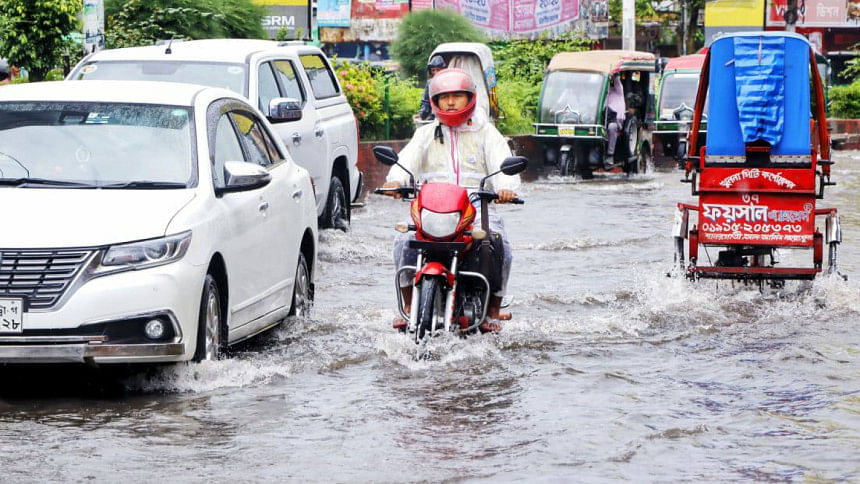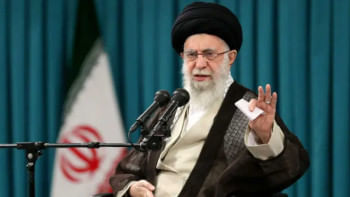Monsoon rain floods Khulna city, exposes failure of Tk 823cr drainage project

The season's first major spell of rain has left large swathes of Khulna city underwater, once again exposing the poor drainage system despite a Tk 823 crore project aimed at addressing waterlogging.
Assistant Meteorologist Animesh Chandra Dhali said Khulna witnessed 47mm of rainfall in six hours from 6:00am, in addition to 36mm in the previous 24 hours.
"This pattern of intermittent rainfall is expected to continue until June 20," he said.
Major city roads went under knee-deep water, while low-lying areas remain inundated up to the waist, causing severe disruption to daily life.
Day labourers, office-goers, and schoolchildren all struggled to navigate flooded streets.
City dwellers blame clogged drains, poor sewer systems, encroachment and lack of renovation of the city's 22 canals, and the filling up of natural reservoirs and rivers as the main reasons behind chronic waterlogging.
Key areas of the city—Ahsan Ahmed Road, Royal Mor, Khan Jahan Ali Road, Bastuhara, Baitypara, Chanmari, Labonchora, Tutpara, Mistripara, and Rupsha Notun Bazar—have been severely affected. The stretch from Dakbangla Mor to Ferryghat Mor is submerged above knee level.
Water has also inundated the roads from Notun Rasta Mor to Abu Naser Specialised Hospital and large parts of the Mujgunni Road area.
"While heading to work this morning, I was shocked to find the road flooded. My motorcycle was halfway underwater," Ward No. 6 resident Tushar Kanti Das told The Daily Star.
"Except for the Khulna-Jashore Highway, almost all roads are under water," he said.
"Construction of drains are still unfinished, so the rainwater has nowhere to go, and last night's rain led to serious waterlogging," he added.
Locals said water from Wards No. 6, 7, and 9 is supposed to drain through Bastuhara and Karigor Para canals into the Mayur River. But due to lack of maintenance, these canals can no longer carry water effectively.
The city has 1,165km of drains, many of which are covered and cleaned manually without any automated system, according to Khulna City Corporation (KCC) officials.
"Earlier, rainwater would recede quickly. But in the past 8–10 years, the problem has worsened. Now, despite so many drains and culverts, water just sits there," said Azmal Haque, a rickshaw puller from Shirish Nagar. "We suffer the most—we can't ride properly, we get fewer passengers, and yet we have to pay the rickshaw owners the full rent."
A Tk 823 crore drainage project, launched in 2018 under former mayor Talukder Abdul Khaleque's tenure, was meant to address the city's chronic waterlogging.
Around Tk 600 crore has already been spent for constructing 200 drains and reviving seven canals, as well the Mayur river.
However, the waterlogging persists.
The project was originally scheduled for completion by December 2023, but it missed the deadline.
A request for an extension until June this year is currently pending with the Ministry of Local Government, Rural Development and Co-operatives.
KCC's Chief Engineer Moshiuzzaman Khan said key components like pump stations and sluice gate repairs are still pending.
"Once these are done, we expect to see actual improvement," he said.
Experts and civil society groups said the problem runs deeper.
Advocate Babul Hawlader, member secretary of the Khulna Nagarik Committee, said tidal and monsoon water now overflows into the city through broken embankments and sluice gates as the beds of the Bhairab and Rupsha rivers have risen due to siltation.
"Moreover, low-lying areas in the western parts of the city, such as Mostafa Mor, Rayermohol, Bil Pabla, and Arongghata, used to function as natural water reservoirs. But housing developers have filled them with sand, eliminating these vital water-retention zones. As a result, even moderate rain now floods the city."
"Without involving both government and local stakeholders, waterlogging in Khulna cannot be resolved," he added.
According to Bangladesh Environmental Lawyers Association (BELA), the authorities identified 460 encroachers and 382 illegal structures on 26 canals in and around Khulna city four years ago, but no significant eviction drive followed.
BELA's divisional coordinator Mahfuzur Rahman Mukul said even dredging work done on the Mayur River was ineffective, as the removed silt was dumped on riverbanks and washed back in by rain.
"If the link between Mayur and Rupsha at Alutala is not restored, there will be no way for tidal flow or drainage," he said.
Sheikh Ashraf-Uz-Zaman, president of the Greater Khulna Development Coordination Committee, said successive mayors had promised to solve waterlogging for four decades without results.
"Now, just one round of rain is enough to flood the city," he said.
"Unless all 22 canals are restored, no project—no matter how expensive—will solve the problem."

 For all latest news, follow The Daily Star's Google News channel.
For all latest news, follow The Daily Star's Google News channel. 



Comments